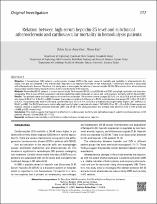| dc.contributor.author | Yayar, Özlem | |
| dc.contributor.author | Eser, Barış | |
| dc.contributor.author | Kılıç, Harun | |
| dc.date.accessioned | 2019-05-13T09:07:39Z | |
| dc.date.available | 2019-05-13T09:07:39Z | |
| dc.date.issued | 2018 | |
| dc.identifier.citation | Yayar, Ö., Eser, B., Kılıç, H. (2018). Relation between high serum hepcidin-25 level and subclinical atherosclerosis and cardiovascular mortality in hemodialysis patients. Anatolian Journal of Cardiology, 19(2), 117-122. | en_US |
| dc.identifier.issn | 2149-2263 | |
| dc.identifier.uri | https://doi.org/10.14744/AnatolJCardiol.2017.8019 | |
| dc.identifier.uri | https://hdl.handle.net/11491/1848 | |
| dc.description.abstract | Objective: In hemodialysis (HD) patients, cardiovascular disease (CVD) is the major cause of mortality and morbidity. In atherosclerotic diseases, iron gets accumulated in the arterial wall. Hepcidin is an important hormone in iron metabolism. Furthermore, hepcidin is associated with atherosclerotic disease. Therefore, this study aims to investigate the relation of serum hepcidin-25 (SH-25) and sub-clinic atherosclerosis measured by carotid intima-media thickness (CIMT) and mortality in HD patients. Methods: We enrolled 82 HD patients in a cross-control study. We measured SH-25 using ELISA kit and CIMT using high-resolution real-time ultra-sonography. After 4 years of first assessment, we investigated the relation between all-cause and cardiovascular mortality and SH-25 and CIMT. Results: Two patients were excluded because of renal transplantation. The survivors were younger (53.7±15.1 vs. 65.2±15.5; p<0.05) and CIMT was lower (0.83±0.2 vs. 0.95±0.2; p<0.05); however, there was no significant difference in SH-25 levels between the groups (29.1±13 vs. 32.4±22.4; p=0.767). The patients who died of CVD were significantly older (63.7±16.1 vs. 53.7±15.1; p<0.05) and had significantly higher CIMT (0.94±0.2 vs. 83±0.2; p<0.05). The SH-25 levels were statistically significantly higher in patients who died of CVD (40.3±25 vs. 29.1±13; p<0.05). Linear regression analysis showed a positive correlation between CIMT and SH-25 in the study population and in those who died from CVD (r=0.41; p<0.05 and r=0.606; p<0.05, respectively). Conclusion: This study suggests that hepcidin is effective in cardiovascular mortality and pathophysiology of subclinical atherosclerosis in HD patients. (Anatol J Cardiol 2018; 19: 117-22) © 2018 by Turkish Society of Cardiology. | en_US |
| dc.language.iso | eng | |
| dc.publisher | Turkish Society of Cardiology | en_US |
| dc.relation.isversionof | 10.14744/AnatolJCardiol.2017.8019 | en_US |
| dc.rights | info:eu-repo/semantics/openAccess | en_US |
| dc.subject | Cardiovascular Mortality | en_US |
| dc.subject | Carotid Intima-Media Thickness | en_US |
| dc.subject | Hemodialysis | en_US |
| dc.subject | Hepcidin | en_US |
| dc.title | Relation between high serum hepcidin-25 level and subclinical atherosclerosis and cardiovascular mortality in hemodialysis patients | en_US |
| dc.type | article | en_US |
| dc.relation.journal | Anatolian Journal of Cardiology | en_US |
| dc.department | Hitit Üniversitesi, Tıp Fakültesi, Dahili Tıp Bilimleri Bölümü | en_US |
| dc.identifier.volume | 19 | en_US |
| dc.identifier.issue | 2 | en_US |
| dc.identifier.startpage | 117 | en_US |
| dc.identifier.endpage | 122 | en_US |
| dc.relation.publicationcategory | Makale - Uluslararası Hakemli Dergi - Kurum Öğretim Elemanı | en_US |


















